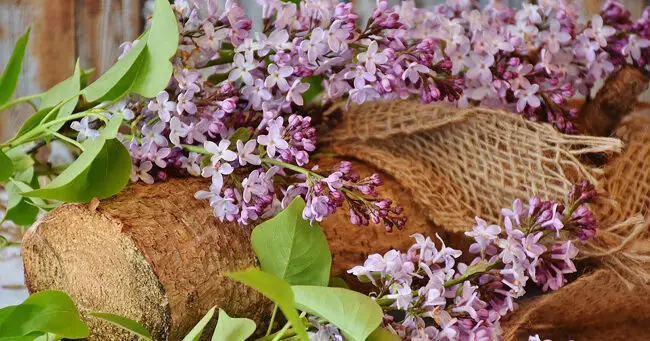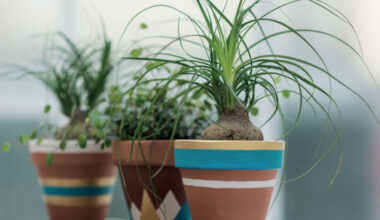Common in gardens in isolated subject or in compound hedges, the lilac can also find its place on a terrace or a balcony planted in pot, indoors.
The dwarf varieties will then be privileged to compose beautiful scenes without taking up too much space while still enjoying the wonderful scent of this shrub.
Contents
Which lilac varieties for indoor?
Choose a variety with reduced dimensions, the classic lilacs need the full ground of a garden. Choose a container of at least 16 inches in diameter or side. Fill it with rose soil or a mixture of garden soil and universal soil amended with organic manure.
Make a good handful of amendments each early spring. Mulch and water to keep the substrate cool, especially in the summer. No need to prune. A simple cleaning is enough: faded flowers, damaged branches. Among them :
- Syringa meyeri ‘Palibin’ with pink/blue flowers;
- Syringa meyeri ‘Josee’ pastel pink;
- Syringa julianae ‘Red Pixie’ purple/wine lily;
- Syringa microphylla ‘Superba’, otherwise known as ‘Small-leaved Lilac’ with a pale purple flowering habit;
- Syringa ‘Bloomerang Pink’, a compact hybrid with a clear pink remontant bloom;
- Syringa persica Laciniata, the lilac of Persia with very cut foliage and blue/purple flowers, hardy up to 5°F.
In which type of pot to cultivate the lilac?
Choose a large pot with a minimum diameter of 16 to 20 inches and the same depth to leave room for the roots. A square or rectangular wooden pot, a large tub, or an unglazed ceramic pot will do the trick.
Avoid bulbous pots that are too difficult to remove and black plastic containers that get too hot in the summer sun.
When to repot the lilac indoor?
Plant your potted lilac in autumn in the mildest areas, everywhere else, wait until spring or choose a hardy variety.
An annual surfacing with compost is sufficient for the first two years after planting, then repotting will be necessary to renew the substrate.
How to plant lilac in a pot?
- The pot must be pierced at the bottom so that water does not stagnate.
- Add a layer of clay balls, gravel or small pebbles to the bottom of the pot to help drainage, as lilacs hate having their roots constantly soggy. The drainage layer should make up about 20% of the pot volume.
- Prepare a mixture of ¼ good soil, ¼ garden soil, ¼ compost and ¼ coarse river sand.
- Pour a layer of the mixture at the bottom of the pot on the drainage bed.
- Place the root ball and adjust the height by adding more mix if necessary so that the collar of the shrub is 1 or 2 inches below the top of the pot.
- Fill in any gaps and pack well around the stem.
- Water copiously and add more mix if necessary.
Where to install a potted lilac indoor?
An exposure to full sunshine sheltered from draughts is ideal in the northern regions of the Loire. To the south, place your lilac in mid-shade in summer to protect it from the scorching midday sun. In winter, it will be able to take place in full sun, but be careful to water it in regions where rainfall is rare in winter!
How to water a lilac indoors?
Like all plants grown in pots, lilacs will need more care than if they were grown in the ground. Be careful, if you are used to grow it in the garden, it will require more care in pots, especially when watering in summer, which must be very regular so that your plant does not ‘grill’, especially exposed on a balcony in full sun!
To be on the safe side, never let the substrate dry more than 1 inch on the surface in summer. In winter, take care that it does not miss water if it does not rain.
Which fertilizer for my indoor lilac?
Prefer an organic fertilizer, less aggressive than a chemical fertilizer, it will be better assimilated by the plant with as much efficiency and this, without weakening it. Scratch in March a mixture of crushed horn and dried blood at the foot of the shrub or pour a handful of organic granules on the surface of the mixture.
The limestone does not frighten it, you can add a handful of chimney ashes at the end of winter, the flowering will be even more opulent!
How do I trim my lilac indoors?
Small pot-grown varieties are only moderately pruned. The removal of wilted inflorescences in spring and autumn on remontant varieties constitutes the major part of the pruning operations.
If necessary, it is possible, still after flowering, to remove the dead wood and to aerate the silhouette a little by pruning the crossing branches in the center of the shrub and by reducing some branches by 1/3. Be careful, because lilac flowers on the wood of the previous year, if you prune too late and too short, the flowering may be compromised!
Diseases and parasites that affect indoor lilacs
Lilac can suffer from mildew. This disease causes a white down on the leaves especially if it is hot and humid. Remove affected branches with disinfected pruning shears.
Insects such as certain butterflies or scale insects can also attack the plant.
Check for the appearance of sawdust and galleries at the base of the shrub. If this is the case, treat the lilac with horticultural oil and Bordeaux mixture. Also cut off the affected branches with disinfected pruning shears between each shrub.
Summary
The good news is that some varieties of lilacs grow very well in pots, so you can easily install them in the living room, or elsewhere in the house. With its generous and fragrant flowering, lilacs will embalm your home in no time.









